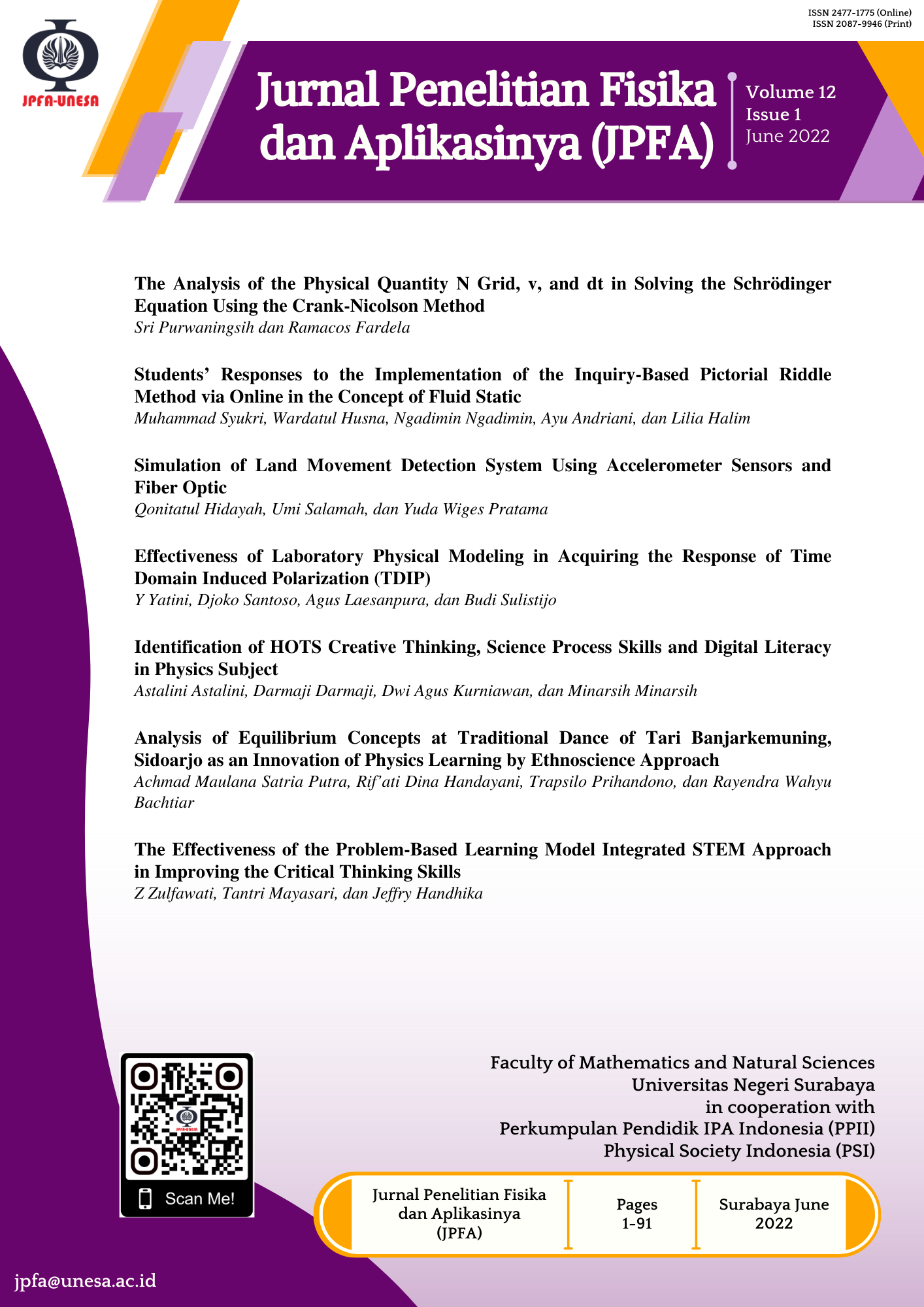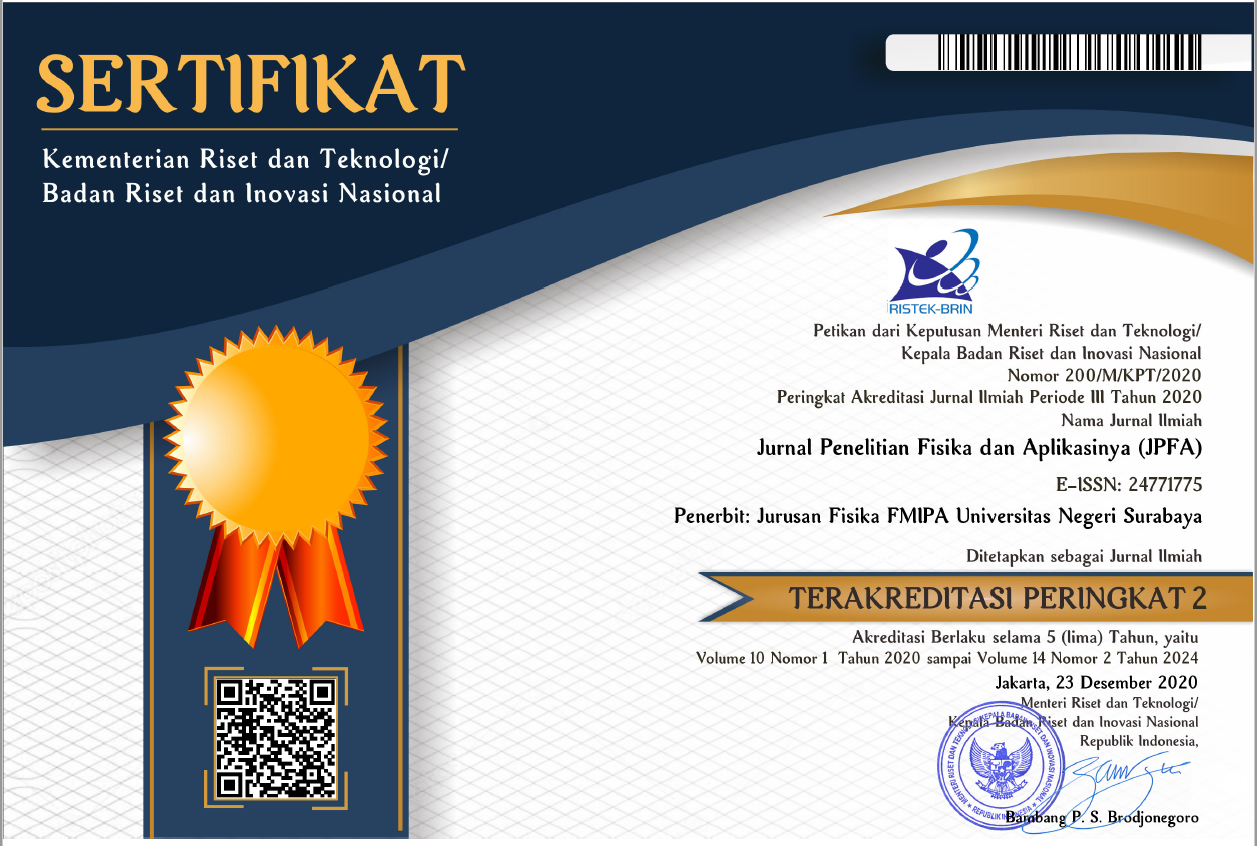Effectiveness of Laboratory Physical Modeling in Acquiring the Response of Time Domain Induced Polarization (TDIP)
DOI:
https://doi.org/10.26740/jpfa.v12n1.p34-46Keywords:
TDIP response, resistivity, chargeability, physical modeling, metal mineral content.Abstract
Induced Polarization (IP) is one of the Geophysical methods that utilize the polarization properties of the rocks for metallic mineral exploration. The problems are how to distinguish the metallic minerals deposit based on the chargeability. The physical modeling of IP is used to study the behavior of TDIP response. The study of a simple mathematical model is carried out to obtain the theoretical curves which are presented as the subsurface parameter. These curves are used as a reference to assess the result of physical modeling. The laboratory physical modeling uses a tank model with a size of (200x100x70) cm3, with a block as a target and water as a host medium. The results show laboratory physical modeling which has been made is quietly good. The approximate position and geometry of the target can be identified. The resistivity inversion modeling is sensitive to recognizing the geometry and position, while the chargeability inversion is on the distribution of metallic minerals. The quantitative correlation between chargeability and iron-ore content is obtained by Dipole-dipole and Wenner configuration. Both are connected exponentially, with a different exponential constant for different block targets.
References
Dusabemariya C, Qian W, Bagaragaza W, Faruwa A, and Ali M. Some experiences of resistivity and induced polarization methods on the exploration of sulfide: A review. Journal of Geoscience and Environment Protection. 2020; 8(11): 68-92. DOI: https://doi.org/10.4236/gep.2020.811004.
Dakir I, Benamara A, Aassoumi H, Ouallali A, and Bahammou YA. Application of induced polarization and resistivity to the determination of the location of metalliferous veins in the Taroucht and Tabesbaste areas (Eastern Anti-Atlas, Morocco). International Journal of Geophysics. 2019; 2019: 5849019. DOI: https://doi.org/10.1155/2019/5849019.
Essa KS and Munschy M. Mineral Exploration from the Point of View of Geophysicists. In Minerals. London: IntechOpen; 2019. DOI: https://doi.org/10.5772/intechopen.84830.
Alfouzan FA, Alotaibi AM, Cox LH, and Zhdanov MS. Spectral induced polarization survey with distributed array system for mineral exploration: Case study in Saudi Arabia. Minerals. 2020; 10(9): 769. DOI: https://doi.org/10.3390/min10090769.
Revil A, Ahmed AS, Coperey A, Ravanel L, Sharma R, and Panwar N. Induced polarization as a tool to characterize shallow landslides. Journal of Hydrology. 2020; 589: 125369. DOI: https://doi.org/10.1016/j.jhydrol.2020.125369.
Yatini Y, Santoso D, and Laesanpura A. Physical Modeling Studies of the Time Domain Induced Polarization (TDIP) Response, Case: Homogeneous Isotropic Medium. Proceedings 3rd Annual Basic Science International Conference (BaSIC). Malang: Universitas Brawijaya Malang; 2013. Available from: http://eprints.upnyk.ac.id/18691/1/2013-Basic.pdf
Loke MH. Tutorial: 2-D and 3-D electrical imaging surveys; 2004. Available from: https://sites.ualberta.ca/~unsworth/UA-classes/223/loke_course_notes.pdf.
Ward SH. The resistivity and induced polarization methods. In Geotechnical and Environmental Geophysics. Tulsa: Society of Exploration Geophysicists. 1990; 147-190. DOI: https://doi.org/10.1190/1.9781560802785.ch6.
Gainullin IK. Theoretical investigation of the ion-induced polarization-charge influence on resonant charge transfer. Physical Review A. 2019; 100(3): 032712. DOI: https://doi.org/10.1103/PhysRevA.100.032712.
Downloads
Published
How to Cite
Issue
Section
License
Copyright (c) 2022 Jurnal Penelitian Fisika dan Aplikasinya (JPFA)

This work is licensed under a Creative Commons Attribution-NonCommercial 4.0 International License.
Author(s) who wish to publish with this journal should agree to the following terms:
- Author(s) retain copyright and grant the journal right of first publication with the work simultaneously licensed under a Creative Commons Attribution-Non Commercial 4.0 License (CC BY-NC) that allows others to share the work with an acknowledgement of the work's authorship and initial publication in this journal for noncommercial purposes.
- Author(s) are able to enter into separate, additional contractual arrangements for the non-exclusive distribution of the journal's published version of the work (e.g., post it to an institutional repository or publish it in a book), with an acknowledgement of its initial publication in this journal.
The publisher publish and distribute the Article with the copyright notice to the JPFA with the article license CC-BY-NC 4.0.
 Abstract views: 362
,
Abstract views: 362
, PDF Downloads: 451
PDF Downloads: 451









